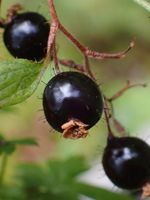Mon-Fri 9am - 5pm Mountain time
Sea Buckthorn (Seaberry) vs Bristly Black Currant
Ribes lacustre
Hippophae rhamnoides l.
CUSTOM GROW
Bristly Black Currant is a native deciduous shrub that grows in moist forests, swamps, and riparian areas. In summer, it produces clusters of dark purple to black berries that provide food for wildlife, while its reddish-purple flowers attract pollinators. The berries are technically edible and enjoyed by some, but many find them unpleasant and bitter.
Thriving in moist soils and shaded locations, Bristly Black Currant helps stabilize soil and supports diverse habitats. It is valuable for conservation plantings, wetland restoration, riparian buffers, and naturalization projects.
Note: When crushed, the berries are known to release an offensive odour.
Sea Buckthorn, aka Seaberry, is a nitrogen fixing shrub that produces attractive berries high in vitamin C.
While we can't confirm claims that the berries are effective in treating various ailments, many people believe consuming the berries helps with arthritis, infections, and asthma, among other things.
Sea Buckthorn plants have attractive pale silvery-green leaves, dense branches, and large thorns, people like to grow in ornamental hedges or as a first row in a shelterbelt.
Note: these plants typically reach maturity and make their sex easily known (females producing fruit) in their 3rd or 4th year of growth. Our seedlings are too young to identify their sex.
Bristly Black Currant Quick Facts
Sea Buckthorn (Seaberry) Quick Facts
Toxicity: prickles may cause an allergic reaction
In row spacing: 0.9 - 1.2 m (3 - 4 ft)

